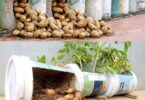Broccoli, with its dense clusters of vibrant green florets, is a nutrient-rich vegetable that has gained popularity for its health benefits and culinary versatility. While many people associate broccoli cultivation with large gardens, it’s entirely possible to grow this nutritious vegetable right at home, even in small spaces like containers made from large plastic bottles. In this article, we’ll explore the step-by-step process of successfully cultivating broccoli in containers, allowing you to enjoy the satisfaction of homegrown produce.

Choosing the Right Container: When selecting containers for growing broccoli, large plastic bottles can be an excellent choice. Cut bottles in half or use their bottom portions to create deep containers that provide ample space for the broccoli’s root system to grow. Ensure the containers are at least 12 inches deep and have a diameter of around 10-12 inches to accommodate the plant’s growth.
Gathering Supplies:
- Large plastic bottles
- Potting mix or well-draining soil
- Broccoli seeds or seedlings
- Fertilizer (preferably balanced or high in nitrogen)
- Watering can or hose with a gentle nozzle
- Mulch (straw or compost)
Sowing Broccoli Seeds:
- Fill the containers with a high-quality potting mix or well-draining soil, leaving about an inch of space below the rim.
- Sow the broccoli seeds according to the recommended spacing on the seed packet. Typically, this is around 18 inches between plants.
- Lightly cover the seeds with a thin layer of soil and gently pat it down to ensure good seed-to-soil contact.
- Water the soil thoroughly, keeping it consistently moist but not waterlogged.
Caring for Broccoli:
- Sunlight: Place your containers in an area that receives at least 6 hours of direct sunlight per day. Broccoli thrives in full sun.
- Watering: Keep the soil consistently moist by watering whenever the top inch of soil feels dry. Use a gentle nozzle to prevent disturbing the soil and young plants.
- Fertilization: Begin fertilizing the broccoli plants with a balanced or nitrogen-rich fertilizer a few weeks after planting. Follow the manufacturer’s instructions for application.
- Thinning: Once the seedlings have a couple of true leaves, thin them if needed to ensure proper spacing between plants. This allows each plant to develop fully.
- Mulching: Apply a layer of mulch around the base of the plants. Mulch helps retain moisture, suppresses weed growth, and regulates soil temperature.
- Pest Control: Monitor your plants regularly for signs of pests like aphids or cabbage worms. Handpick these pests or use natural insecticides to protect your broccoli.
Harvesting Broccoli: Broccoli is ready for harvest when the central head is firm, tight, and approximately 4-7 inches in diameter. Use a sharp knife to cut the main head just above where it meets the stem. Leave the plant in the container, as many varieties will produce smaller side shoots that can be harvested in the coming weeks.
Conclusion: Growing broccoli at home in containers, even using large plastic bottles, can be a rewarding experience that provides you with fresh and nutritious produce right at your fingertips. By following these steps and giving your broccoli plants the care and attention they need, you can enjoy a bountiful harvest of this delicious vegetable without the need for a large garden space. Whether you’re an experienced gardener or a beginner, container gardening opens up a world of possibilities for cultivating your favorite vegetables in limited spaces.






